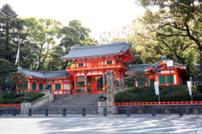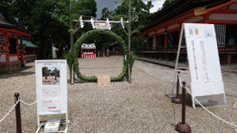Amulet roots, Chinowa Yasaka Shrine Somin Shorai descendants
Yoshie Doi
 |
 |
During the Heian period, Yasaka Shrine was called Gionsha or Gion Kanjin-in, and after 974 (Ten’en 2nd year) it was called Tendai Betsuin and was the Matsuji (belonging to Hieizan Enryakuji Temple). It is a temple with a strong color of Shinto and Buddhism since the Heian period, and was renamed Yasaka Shrine in 1872 due to the separation of Shinto and Buddhism.
What is the legend of Somin Shorai?
Somin Shorai, which is said to be Japan’s first amulet, will appear in “Bingo no Kuni Fudoki”. The story unfolds as follows.
Once upon a time, Mutoshin was traveling. When he asked the rich Kotanshorai (younger brother) and the poor Sominshorai (brother) to stay, He did not lend the rich giant, but the poor Somin was willing to provide him lodging and giving chestnut rice. A few years later, He took his child and visited Somin as a thank-you. Somin and his family were spared from the plague with a Cjino-wa ( Ring made of thatch), but others were said to have died. Even now, on the last day of June, we passed through the Chino-wa at the Nagoshino-harae.
(A ceremony to pray the removing disaster for half a year until June 30)
We pray for the end of the plague.
Until the Showa era, on the day of Gion Matsuri, Chimaki with an amulet stating “Somin Shorai’s descendants” were thrown from the Yamhoko and distributed to onlookers along the road. Unfortunately, in 1976, it occursed dangerous accident because the Chimaki thrown in were hitten audience’ s eye. They were refrained from doing so, in 1982 it occursed accidenr again as breaken bone who tried to take the Chimaki. so that from 1983 this Chimaki throwing is totally prohibited. The Chimaki came to be purchased in advance.
It was very popular because it was said, “By throwing the Chimaki that sealed uncleanness and disasters in the Chimaki, it turns into good fortune and serves as a talisman to prevent evil.” When I was a kid, I remember sitting on the second floor of a Kyomachiya and having the Chimaki thrown.
By the way, this Chimaki was purchased by the Hayasikata (Players) themselves and performed best. So to speak, it was a communication of the festival between the Yamahoko and the audience, and it was also a communication where the audience applauded in response to the shout of “Whitto, Whit” by the gods.
The end of document
